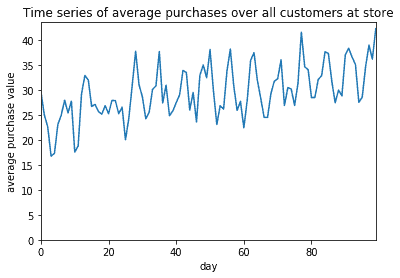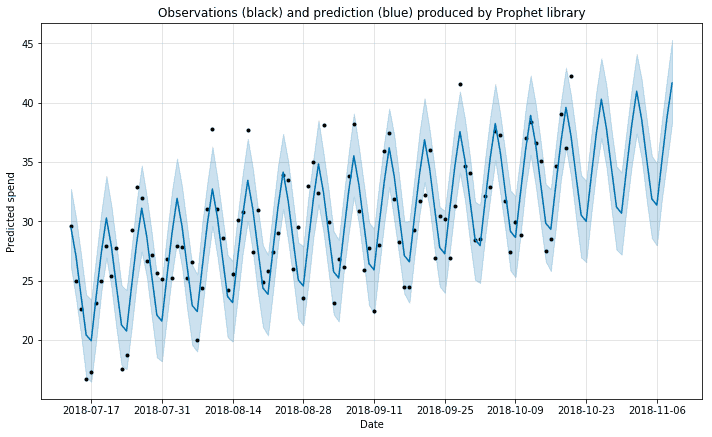
Earlier I wrote another post about predicting the spend of a single known customer. There is a related problem which is predicting the total spend of all your customers, or a sizeable segment of them.
If you don’t need to predict the spend of an individual customer, but you’re happy to predict it for groups of customers, you can bundle customers up into groups. For example rather than needing to predict the future spend of Customer No. 23745993, you may want to predict the average spend of all customers in Socioeconomic Class A at Store 6342.
Fast Data Science - London
In this case the great advantage is that you would not have so many empty values in your past time series. So your time series may look like this:

This means you can use a time series library such as Prophet, developed by Facebook.
Here’s what Prophet produces when I give it the data points I showed above, and ask it to produce a prediction for the next few days. You can see that it’s picked up the weekly cycle correctly.

This approach would be very useful if you only needed the data for budgeting or stock planning purposes for an individual store and not for individual customers.
However if you had small enough customer segments, you may find that the prediction for a customer’s segment is adequate as a prediction for that customer.
The next step up in complexity is multilevel models, where you use a different level of model for each region or economic group of customers, and combine them into a single group model.
To get the maximum predictive power you can try ways of combining time series methods with a predictive modelling approach, such as taking the results of a time series prediction for a customer’s segment and using it as input to a predictive model.
If you have a prediction problem in retail, or would like to some help with another business problem in data science or AI, I’d love to hear from you. Please contact me via the contact form.
Unleash the potential of your NLP projects with the right talent. Post your job with us and attract candidates who are as passionate about natural language processing.
Hire NLP Experts
Thomas Wood presents the Clinical Trial Risk Tool before the November meeting of the Clinical AI Interest Group at Alan Turing Institute The Clinical AI Interest group is a community of health professionals from a broad range of backgrounds with an interest in Clinical AI, organised by the Alan Turing Institute.

Fast Data Science will appear at Ireland’s Expert Witness Conference on 20 May 2026 in Dublin On 20 May 2026, La Touche Training is running the Expert Witness Conference 2026, at the Radisson Blu Hotel, Golden Lane, Dublin 8, Ireland. This is a full-day event combining practical workshops and interactive sessions, aimed at expert witnesses and legal professionals who want to enhance their expertise. The agenda covers critical topics like recent developments in case law, guidance on report writing, and techniques for handling cross-examination.

Guest post by Alex Nikic In the past few years, Generative AI technology has advanced rapidly, and businesses are increasingly adopting it for a variety of tasks. While GenAI excels at tasks such as document summarisation, question answering, and content generation, it lacks the ability to provide reliable forecasts for future events. GenAI models are not designed for forecasting, and along with the tendancy to hallucinate information, the output of these models should not be trusted when planning key business decisions. For more details, a previous article on our blog explores in-depth the trade-offs of GenAI vs Traditional Machine Learning approaches.
What we can do for you